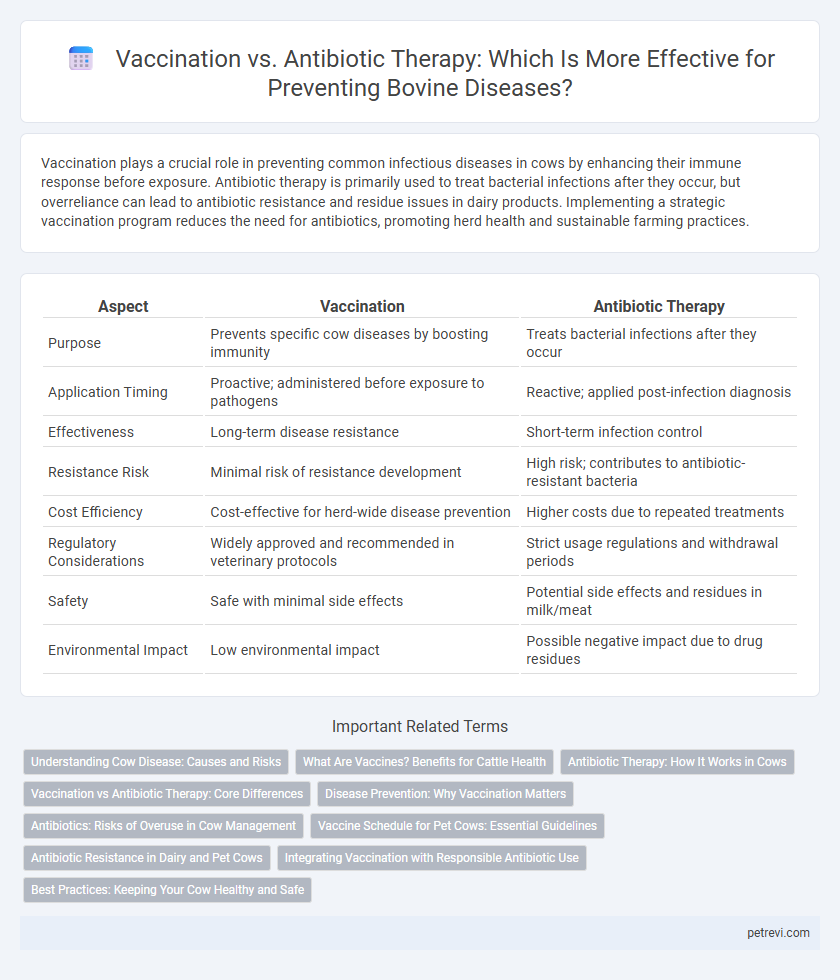Vaccination plays a crucial role in preventing common infectious diseases in cows by enhancing their immune response before exposure. Antibiotic therapy is primarily used to treat bacterial infections after they occur, but overreliance can lead to antibiotic resistance and residue issues in dairy products. Implementing a strategic vaccination program reduces the need for antibiotics, promoting herd health and sustainable farming practices.
Table of Comparison
| Aspect | Vaccination | Antibiotic Therapy |
|---|---|---|
| Purpose | Prevents specific cow diseases by boosting immunity | Treats bacterial infections after they occur |
| Application Timing | Proactive; administered before exposure to pathogens | Reactive; applied post-infection diagnosis |
| Effectiveness | Long-term disease resistance | Short-term infection control |
| Resistance Risk | Minimal risk of resistance development | High risk; contributes to antibiotic-resistant bacteria |
| Cost Efficiency | Cost-effective for herd-wide disease prevention | Higher costs due to repeated treatments |
| Regulatory Considerations | Widely approved and recommended in veterinary protocols | Strict usage regulations and withdrawal periods |
| Safety | Safe with minimal side effects | Potential side effects and residues in milk/meat |
| Environmental Impact | Low environmental impact | Possible negative impact due to drug residues |
Understanding Cow Disease: Causes and Risks
Cow diseases often stem from bacterial, viral, and parasitic infections, with common causes including pathogens like Mycobacterium bovis and Escherichia coli. Vaccination plays a crucial role in preventing infectious diseases by stimulating the immune system to recognize and fight specific pathogens before infection occurs. Antibiotic therapy, while effective for treating bacterial infections, carries risks such as antibiotic resistance and residue in milk, making vaccination a preferred strategy for proactive disease prevention in dairy and beef cattle.
What Are Vaccines? Benefits for Cattle Health
Vaccines stimulate the immune system of cows to recognize and fight specific pathogens, reducing the incidence of infectious diseases. Effective vaccination programs enhance cattle health by preventing outbreaks, decreasing the need for antibiotic treatments, and improving overall herd immunity. This proactive approach leads to better milk production, growth rates, and lowers veterinary costs associated with disease management.
Antibiotic Therapy: How It Works in Cows
Antibiotic therapy in cows targets bacterial infections by inhibiting cell wall synthesis, protein production, or DNA replication to eliminate harmful pathogens and reduce inflammation. It is commonly used to treat mastitis and respiratory infections, improving recovery rates when administered promptly and accurately. Proper dosage and treatment duration are critical to prevent antibiotic resistance and ensure effective disease control in bovine health management.
Vaccination vs Antibiotic Therapy: Core Differences
Vaccination in cows promotes long-term immunity by stimulating the animal's immune system to recognize and combat specific pathogens, reducing the incidence of infectious diseases. Antibiotic therapy targets active infections by eliminating bacteria but does not provide immune memory, leading to potential resistance with overuse. Effective disease prevention in cattle relies on prioritizing vaccination to minimize antibiotic dependency and improve herd health outcomes.
Disease Prevention: Why Vaccination Matters
Vaccination plays a crucial role in cow disease prevention by stimulating the immune system to recognize and fight specific pathogens before they cause illness, reducing the need for antibiotic therapy. Relying on vaccines helps decrease antibiotic resistance, promoting healthier herds and sustainable livestock farming. Effective vaccination programs improve overall herd immunity, minimizing outbreaks of common bovine diseases such as bovine respiratory disease and mastitis.
Antibiotics: Risks of Overuse in Cow Management
Antibiotic therapy in cow disease prevention poses significant risks, including the development of antibiotic-resistant bacteria that threaten animal and human health. Overuse of antibiotics can disrupt the natural microbiota in cows, leading to increased susceptibility to infections and reduced effectiveness of treatments. Implementing vaccination programs reduces reliance on antibiotics, promoting sustainable cow management and minimizing resistance risks.
Vaccine Schedule for Pet Cows: Essential Guidelines
A well-structured vaccine schedule is crucial for pet cows to ensure effective prevention against common bovine diseases such as Bovine Respiratory Disease and Clostridial infections. Core vaccines typically include those for Infectious Bovine Rhinotracheitis, Bovine Viral Diarrhea, and Leptospirosis, administered according to age and risk factors, with boosters every six months to maintain immunity. Coordinating timely vaccinations reduces reliance on antibiotic therapy, which helps prevent antimicrobial resistance and promotes long-term herd health.
Antibiotic Resistance in Dairy and Pet Cows
Vaccination plays a critical role in preventing infectious diseases in dairy and pet cows, reducing the necessity for antibiotic use and thereby mitigating the risk of antibiotic resistance. Overreliance on antibiotic therapy in cows contributes to the emergence of resistant bacterial strains, complicating treatment outcomes and posing threats to both animal and public health. Implementing comprehensive vaccination programs alongside responsible antibiotic stewardship is essential to control disease effectively while preserving antibiotic efficacy in bovine populations.
Integrating Vaccination with Responsible Antibiotic Use
Integrating vaccination with responsible antibiotic use enhances cow disease prevention by reducing infection rates and minimizing antibiotic resistance. Vaccination stimulates herd immunity against common bovine pathogens, lowering the need for therapeutic antibiotics. Strategic vaccination programs combined with targeted antibiotic therapy ensure sustainable health management and improve overall productivity in dairy and beef cattle operations.
Best Practices: Keeping Your Cow Healthy and Safe
Vaccination is a proactive strategy that enhances a cow's immune system against specific diseases, significantly reducing the incidence and severity of infections. Antibiotic therapy, while essential for treating bacterial infections, should be used judiciously to prevent resistance and ensure long-term herd health. Implementing a comprehensive vaccination schedule combined with proper hygiene and management practices offers the best prevention approach to keep cows healthy and safe.
Vaccination vs Antibiotic Therapy for Cow Disease Prevention Infographic

 petrevi.com
petrevi.com